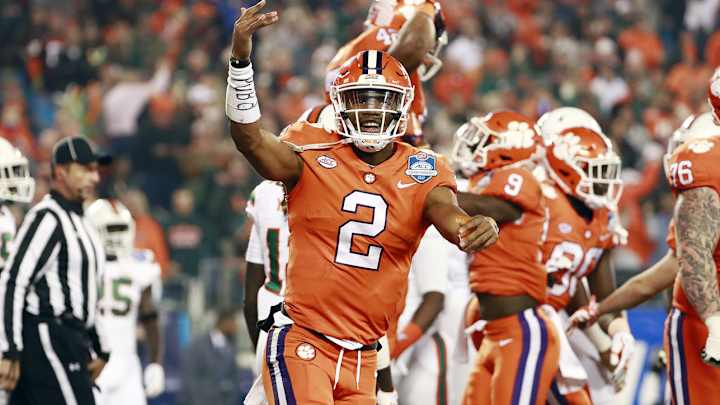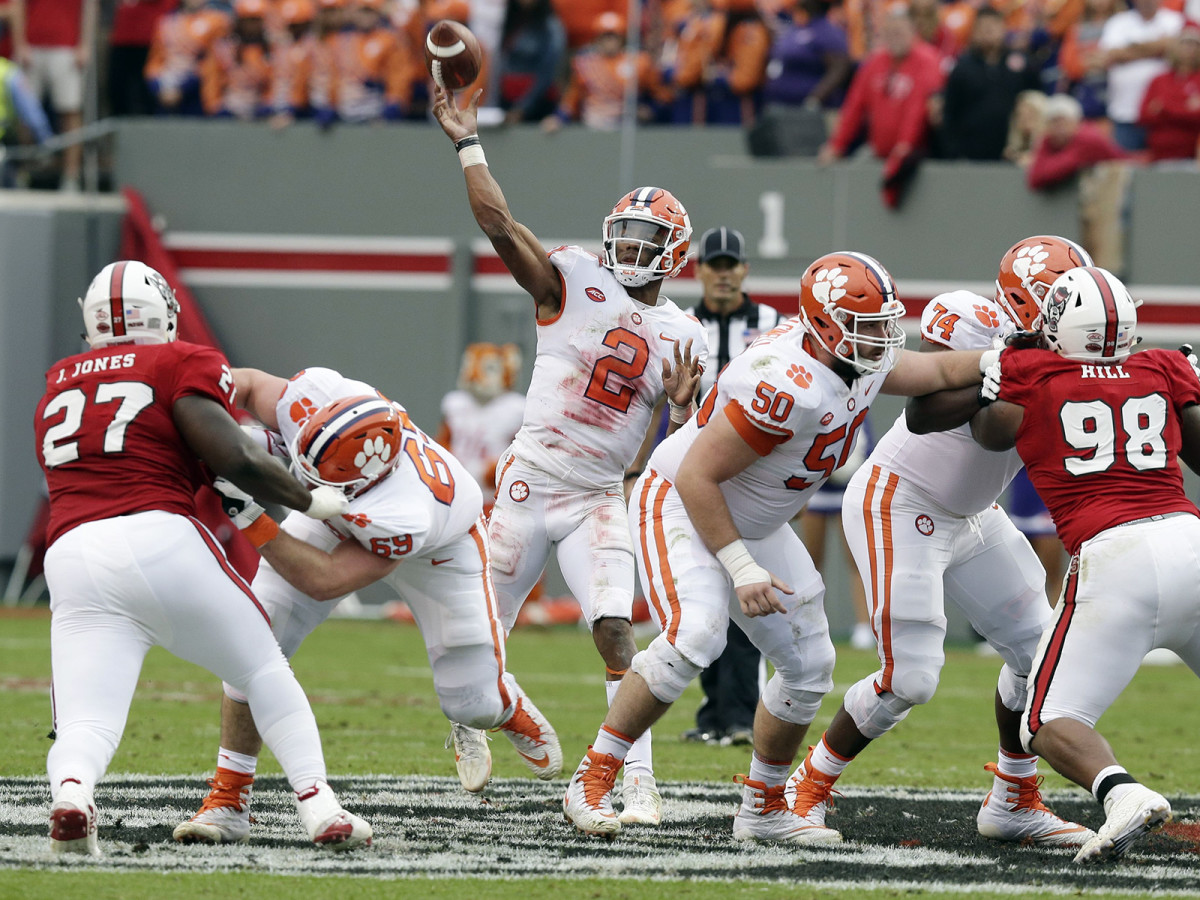How Kelly Bryant Made Replacing Deshaun Watson Look Easier Than It Was

The biggest question entering Clemson’s 2017 season was simple: How do you replace a legend? When star quarterback Deshaun Watson declared for the NFL draft last January, moments after leading the Tigers to a national championship, he left behind a yawning void that no single player reasonably could have been expected to fill. In two-plus seasons as a starter Watson had gone 32–3; accounted for 12,094 yards of total offense and 116 touchdowns; set program records in passing efficiency (157.5) and completion percentage (67.4); twice finished in the top three of the Heisman Trophy voting; and led the team to back-to-back national championship games.
Watson was not the only game-changer who departed Death Valley in the offseason. Clemson’s exodus of excellence on offense included its top running back (Wayne Gallman), an All-ACC tight end (Jordan Leggett), a first-team All-ACC center (Jay Guillermo) and two of the team’s top three wide receivers (Mike Williams and Artavis Scott).
The Tigers entered the fall facing serious doubts about their ability to remain among college football’s elite. They then proceeded to plow through the regular season in a manner befitting a dynastic juggernaut, blowing out Miami 38–3 in the ACC championship game to enter their third straight playoff—and a third straight date with Alabama—as the No. 1 seed.
Less than a month after Watson hung 463 total yards and four touchdowns on the Crimson Tide’s fearsome defense in last January’s 35–31 national title win, Clemson’s staff knew it would need to reconfigure its scheme for an unproven quarterback and a cast of skill players that lacked a true headliner. Co-offensive coordinator Jeff Scott described a meeting that month in which players were shown a chart displaying the team’s marks in major statistical categories over recent seasons. The message was simple: The Tigers had dealt with roster turnover before, and their offense could succeed again if players focused on reaching their personal ceilings. “Obviously, the story line in the offseason was about all of the guys that were leaving,” Scott says. “And these guys really never listened to that. They really just went to work and bought into doing things the same way that we have done things in the past.”
The retooling effort would center on replacing Watson. There were three main candidates entering fall camp: junior Kelly Bryant, redshirt freshman Zerrick Cooper and true freshman Hunter Johnson. All of them boasted flattering recruiting pedigrees, especially Johnson, who had flashed major upside while starring at Brownsburg (Ind.) High. The U.S. Army All-American Bowl MVP, he was rated the No. 2 pro-style passer in the class of 2017 by 247Sports. But true freshmen rarely are ready to be handed the keys of Power 5 attacks—even those who, like Johnson, enroll early and take part in spring workouts. While Bryant’s experience was minimal, he had at least thrown a pass in a college game. In late August, coach Dabo Swinney announced Bryant would start the Sept. 2 season opener against Mid-American Conference cellar-dweller Kent State.
In Scott’s view, quarterback competitions typically can be divided into two types. “One is, that you’re trying to find a guy that’s good enough,” he says. “And the other is, you have several guys that are really good and have potential to be great, and you’ve got to figure out which one is the first one to run out there and lead your team.”
Clemson felt its competition fell into the latter category, but Bryant had a lot to prove despite his strong gridiron bloodlines: His cousin, Martavis Bryant, played wide receiver at Clemson from 2011 to ’13 before being drafted in the fourth round by the Steelers. In February ’14, Kelly was hospitalized for nearly a month as he battled Crohn’s disease; his weight fell more than 50 pounds and he had emergency surgery to remove a -softball-sized abscess obstructing his lower intestine. While he became a finalist for South Carolina’s Mr. Football award as a senior at Wren High in Piedmont, there was little evidence to suggest that he was ready to roast opposing defenses the way Watson had so routinely.
Entering 2017, the 6' 4", 220-pound Bryant had attempted only 18 passes for 75 yards and rushed 35 times for 178 yards. Though he had done enough to beat out the other talented signal-callers, it remained unclear whether his encouraging performance in workouts would translate to the bright lights. Making those same throws while keeping his cool in hostile road environments and dealing with rugged ACC pass-rushers like North Carolina State’s Bradley Chubb, Boston College’s Harold Landry and Wake Forest’s Duke Ejiofor would be a far more difficult challenge. In making this transition, it was imperative that Bryant heeded a simple piece of advice. “You don’t have to be Deshaun,” Clemson coaches told him. “We want you to just be Kelly.”
To help him be Kelly, the staff scaled back the passing attack and instead relied more on their deep corps of tailbacks, their seasoned offensive line and Bryant’s mobility. Clemson increased its rushing output from 169.7 yards per game last season to 204.1 yards, and with Watson no longer slinging arrows from the pocket, its passing production declined from an average of 333.9 yards to 244.1.
The Tigers spread Gallman’s heavy workload among Bryant, sophomore Tavien Feaster, freshman Travis Etienne and juniors Adam Choice and C.J. Fuller. Etienne, a four-star recruit from Jennings (La.) High who didn’t issue a verbal commitment to Clemson until less than a week before National Signing Day last February, emerged as one of the best runners in the ACC, leading the conference with 7.22 yards per rush among players with at least 70 carries. (Etienne has 103 heading into the Alabama game.)
Bryant points to the Tigers’ 14–6 win over Auburn on Sept. 9 as a turning point for him. Although the Tigers recorded by far their lowest point total of the season in that game, that was Bryant’s first start against an elite opponent. He passed for only 181 yards and no touchdowns, but accounted for both of Clemson’s scores—a three-yard run in the second quarter, and a 27-yard scamper in the third—against one of the most stifling defenses in the country. (Auburn ranked eighth among Power 5 teams in yards allowed per play.) “Looking back on it,” Bryant said after the victory in Death Valley, which began to show people around the country that he could not just be a serviceable replacement but a star for Clemson, “I feel like that was where I began to get my rhythm. My confidence began to grow from that weekend and on into the season. For me, it was really big.”
A week later he piloted a 47–21 victory over then No. 14 Louisville in his first road start, throwing for 316 passing yards and rushing for two TDs. The world took notice. In Houston, now with the Texans, Watson replied to a Twitter user who suggested to Watson that Bryant “might be the next” Watson, “He will be better than me!”

All season long Clemson’s stout defense was a big part of the team’s success. It is stuffed with a staggering collection of future pros whom coordinator Brent Venables seemingly always deploys in the right positions to snuff out opponents’ run games and short-circuit their passing attacks. The Tigers don’t allow many big plays, their linebackers excel at wrapping up ballcarriers in space, and there is no defensive tackle tandem in college football more formidable than junior Christian Wilkins and sophomore Dexter Lawrence—two immovable, disruptive space-eaters who check in at 640 pounds combined. Clemson usually has so many advantageous individual matchups when its defense is on the field that opponents are forced to settle for small gains on plays gone awry. The Tigers allowed more than 25 points in a game only twice this season, and the last three teams they faced totaled only 16 points and one garbage-time touchdown. All told, Clemson yielded just 0.89 points per drive, the lowest figure in the country.
But it would be Bryant’s emergence that would be key to Clemson’s return to the top of the mountain. Bryant would go on to guide Clemson through a rigorous schedule that included road tests against Virginia Tech and North Carolina State; the Tigers’ lone loss came on Oct. 13 at Syracuse, 27–24, when he had to leave before halftime with a concussion. Bryant turned in a handful of big-time performances throughout the fall, but he saved one of his gems for an opportune moment: In the ACC championship game, against a stingy Hurricanes defense with designs on exploiting the Tigers’ tendency to fumble, Bryant connected on his first 15 pass attempts and finished 23 of 29 for 252 yards and a touchdown. That raised his completion percentage to 67.4, the highest among all qualifying ACC quarterbacks. Rather than buckling under the pressure of trying to live up to a legend, Bryant has shined as the pilot of an offense tweaked to accentuate his strengths as an agile playmaker.
“There were a lot of questions for me, but I don’t feel like—I tried not to put any pressure on myself,” Bryant told reporters. “I just tried to go out there and just tried to create my own game and just tried to be my own quarterback because I knew I couldn’t—I knew I wasn’t going to be Deshaun.” Adds Scott, “One quality that you’re looking for in your quarterback is that he doesn’t get rattled, he’s somebody that you can count on. That’s what Kelly does for us. He does a great job of managing the game, making really good decisions, and really just being locked in and focused.”
By leaning on their running game and not asking Bryant to step too far out of his comfort zone as a passer, Clemson kept its offense on track a year after losing the electric, dual-threat dynamo who’d commanded it to devastating effect the previous two-plus seasons.
Said Swinney, “I felt like we’d be able to win in the trenches and run the ball a little more effectively than we did last year. And that’s something that—that’s exactly what we’ve been able to do.”
Clemson enters its playoff semifinal ranked second in the ACC with 35.4 points per game, which is more than sufficient given the Tigers’ dominance on the other side of the line of scrimmage. Clemson doesn’t need to give its defense a huge margin for error by scoring in the 30s and 40s, because opponents typically can’t muster more than two touchdowns: The Tigers are allowing just 12.8 points per game, second only to Alabama’s 11.5. “It was an interesting dynamic this year,” redshirt junior wide receiver Hunter Renfrow said of the offense. “We don’t have a superstar. We have guys that are really good players.”
That formula has Clemson two wins away from bringing home the program’s third national championship and becoming only the second unanimous repeat title winner this century. (The other is Alabama in 2011 and ’12. USC claimed championships in ’03 and ’04, but the first was shared with LSU.)
Unlike, say, Texas A&M—which rode Johnny Manziel’s brilliance to an 11–2 season in ’12, only to fail to exceed nine wins in five subsequent seasons—Clemson did not need a transcendent player to carry it to the sport’s competitive summit. Swinney and his staff have built a sturdy foundation, with enough talent and depth amassed through recruiting, that’s capable of weathering the loss of a legend.
